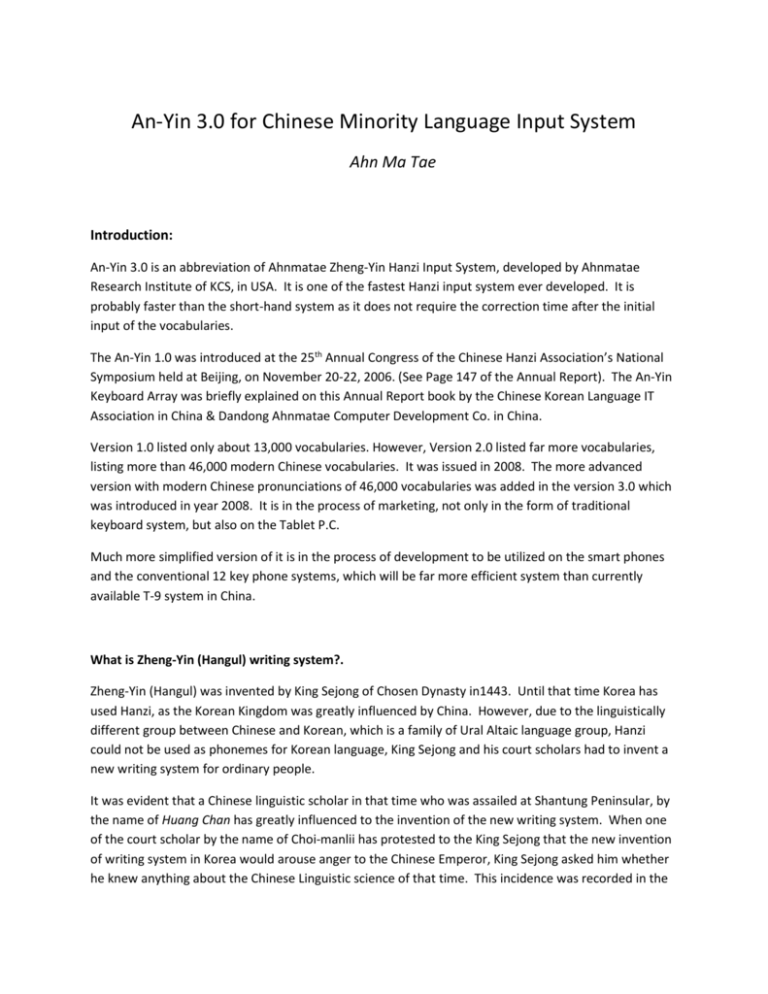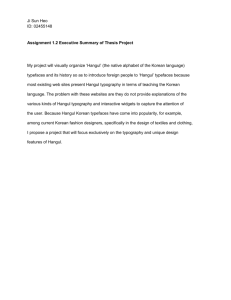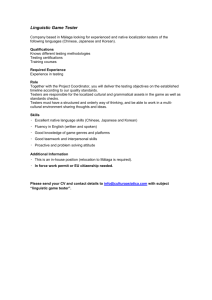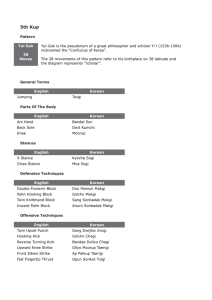An-Yin 3.0 for Chinese Minority Language Input System Ahn Ma Tae
advertisement

An-Yin 3.0 for Chinese Minority Language Input System Ahn Ma Tae Introduction: An-Yin 3.0 is an abbreviation of Ahnmatae Zheng-Yin Hanzi Input System, developed by Ahnmatae Research Institute of KCS, in USA. It is one of the fastest Hanzi input system ever developed. It is probably faster than the short-hand system as it does not require the correction time after the initial input of the vocabularies. The An-Yin 1.0 was introduced at the 25th Annual Congress of the Chinese Hanzi Association’s National Symposium held at Beijing, on November 20-22, 2006. (See Page 147 of the Annual Report). The An-Yin Keyboard Array was briefly explained on this Annual Report book by the Chinese Korean Language IT Association in China & Dandong Ahnmatae Computer Development Co. in China. Version 1.0 listed only about 13,000 vocabularies. However, Version 2.0 listed far more vocabularies, listing more than 46,000 modern Chinese vocabularies. It was issued in 2008. The more advanced version with modern Chinese pronunciations of 46,000 vocabularies was added in the version 3.0 which was introduced in year 2008. It is in the process of marketing, not only in the form of traditional keyboard system, but also on the Tablet P.C. Much more simplified version of it is in the process of development to be utilized on the smart phones and the conventional 12 key phone systems, which will be far more efficient system than currently available T-9 system in China. What is Zheng-Yin (Hangul) writing system?. Zheng-Yin (Hangul) was invented by King Sejong of Chosen Dynasty in1443. Until that time Korea has used Hanzi, as the Korean Kingdom was greatly influenced by China. However, due to the linguistically different group between Chinese and Korean, which is a family of Ural Altaic language group, Hanzi could not be used as phonemes for Korean language, King Sejong and his court scholars had to invent a new writing system for ordinary people. It was evident that a Chinese linguistic scholar in that time who was assailed at Shantung Peninsular, by the name of Huang Chan has greatly influenced to the invention of the new writing system. When one of the court scholar by the name of Choi-manlii has protested to the King Sejong that the new invention of writing system in Korea would arouse anger to the Chinese Emperor, King Sejong asked him whether he knew anything about the Chinese Linguistic science of that time. This incidence was recorded in the royal court annals journals. Due to some scholars’ protests King Sejong, therefore, had to postpone the proclamation of his new invention until 1446. So, the official birth of this new invention of the remarkable writing system is known as year 1446 instead of 1443. Original Zheng-Yin alphabet had 28, consisting of 17 consonants and 11 vowels. However, 3 consonants and one vowel were dropped off from usage around 1933 in the simplification process for modern usage. What is remarkable about this new invented writing system is that the consonants are consisted of 5 basic symbols of where the sounds were created. Basic consonants design (features of sound creating organs in the order of left of face) ㅁ (m) labial sound (순음, shape of opened mouth lips) ㅅ (s) dental sound (치음, shape of sharp teeth) ㄴ (n) lingual sound (설음, shape of tongue tip upward) ㄱ (g) molar sound (아음, shape of tongue root touching the velum) ㅇ (ng) throat sound (후음, shape of round throat) By adding horizontal line and/or dot on above basic consonants will make other alphabets with similar sounds or additional sounds. It can create hundreds and thousands of consonant sound alphabets which can be transcribed all the sounds in the nature including human language; In the labial sound group: ㅁ(m), ㅂ(b), ㅃ(bb), ㅍ(p,) ㅍㅇ(f), ㅂㅇ(v) could be made. In the dental sound group: ㅅ(s), ㅈ(g), ㅉ(j,) ㅊ(ch), ㅊㅎ(tz), ㅈㅇ(z),ㅊㅇ(tch) could be made In the lingual sound group: ㄴ(n), ㄷ(d) ㄸ(dd), ㅌ(t), ㅌㅇ(th), ㄷㅈ(dz) ㅌㅈ(tz) could be made. In the Tung root sound group: ㄱ(g), ㄲ(k or gg), ㅋ(kh), ㄹ(r), ㄹㄹ(l) could be made. In the throat sound group: ㅇ(ng), ㅎ(h) could be made. However, “ㅇ(ng)” before the vowel, as in the case of the initial of the syllable character lose the sound value and used only as a fill-code. Basic vowel design (features of cosmic elements) “.” (a) A dot or a small circle, as a symbol of round sun or Heaven.(천) “ㅡ”(eu) Flat horizontal line, as a symbol of flat Earth.(지) “ㅣ”(ee) Straight vertical line, as a symbol of upright Man.(인) According to the In(음) and Yang(양) theory, when the sun is located above the earth, it makes Yang sound ㅗ(o). When it is located under the earth( ㅡ), sound created is ㅜ(oo), In sound. When the sun is located on the right side of a man, it creates Yang sound ㅏ (aa), and when the sun moves to the left side of the man, it creates Ying sound, ㅓ(uh). With these basic alphabets, adding one more dots can make iotized(or palatized sound vowels, such as: ㅑ(ya),ㅕ(yeo),ㅛ(yo),ㅠ(iu), ㅒ(yae),ㅖ(ye). Also hundreds and thousands of compound or complex vowels, such as ㅢ(eu),ㅐ(ae),ㅔ(ie),ㅘ(wa)ㅙ(wae),ㅚ(oe,)ㅟ(wee), ㅝ(wo), ㅞ(we). An-Yin 3.0 keyboard also has old Zheng-Yin alphabets assigned on the upper portion of the keys with similarly sounded value alphabets, that it can also type old documents when it is necessary to reproduce them. When it is used only for the modern Korean language, it doesn’t need. However, during the development of Chinese language input system, it has used considerable number of them. Zheng-Yin can create more than 300 Million syllables. Zheng-Yin consonants and vowels cannot be used independently when it is used as a character. It should compose as a syllable character. The rules how to combine them are set in the book of 훈민정음 해례 written in 1447. It has not only explanations on who, when, why and how it was created, but also how to combine them as a syllable character was written in it. According to the rules of its composition of alphabets into syllables, it can combine two or three elements of initial consonants, and secondary or peak vowels and /or final trailing consonants, its total numbers of syllables can be more than 300 million syllable characters. It is the reason why Zheng-In can be utilized as the most suitable world language transcriber, not the IPA (International Phonetic Alphabet). Zheng-Yin 3.0 is the first non-Korean application to process on computer. The original developer of Ahnmatae keyboard is a South Korea born citizen. However, due to the military dictatorship in 1960’s in S. Korea, he had to escape to US as a political refugee and started research in Hangul (name used as Zheng-Yin in South Korea) from 1977. Originally, he got helps from American computer engineers and Korean-American Engineers. However, they were not much helpful due to the fact they were ignorant of Hangul. So, He had search for the help from the North Korean expert s in 80’s and Korean-Chinese expert in China in 90’s. An extensive research was conducted with Professor Jin Xuezi of Yanbian University, computer department in 1996-97. According to her research, the keyboard array memory time required for the Ahnmatae keyboard was 27 minutes, in comparison to 59 minutes for Korean Standard keyboard. She hired four female medical school graduates for one full year for her research. Their Hangul input in serial input system for Ahnmatae keyboard was approximately 50 % faster than South Korean Standard keyboard. In 1999, another Yanbian University computer department teacher assisted Ahnmatae to develop a simultaneous input system with Ahnmatae keyboard and hired Mrs. Sue Suezi, a Korean language magazine reporter to be familiarizing the system. In the year 2000, Ahnmatae was invited to the East Asian Language application seminar, conducted at Shenyang, Dungbei University. Thru this lecture, Ahmatae became known to Chinese, Japanese and Korean experts in this field. Meantime, he has hired a Chinese third generation Korean who should practice this new invention of Hangul simultaneous input system. Her name is Cui Hexian. She became the world record holder of Ahnmatae Hangul Keyboard input system by breaking 1,500 strokes per minutes at Shenchen in 2003. First Korean IME processor with Ahnmatae Keyboard South Korea KAIST (Korea Advanced Institute of Science and Technology) Artificial Intelligence Research lab invited Ahnmatae to be their invited researcher. He has accepted the offer to be co-worker to develop Ahnmatae Simultaneous Input System to be used on the Microsoft’s IME (Input Method Editor) system. During his research in that institution, the North Korean scholars, notably of the North Korean Science Seneca, Applied Language Department scientist suggested a few revisions on the Ahnmatae Keyboard. Also this period, many suggestions came from China as well as in South Korea. Notable scholar, a Kong Byung Woo typing system expert, Professor, Han Sang Young of Chun-Nam University suggested several key position changes. The final version was reported on all the Korean medias on April 9 and 10, 2003at the Ministry of Science & Technology and at KAIST. The recommendations were submitted to the South Korean Authorities to be it the second alternative standard to the Korean Keyboard Input system. About the same time, the scientist in China as well as in North Korea also suggested it to be the future alternative Korean keyboard standard in their respective countries. However, none of these countries has adopted it as the second alternative standard keyboard. KAIST developed input systems are all free, even the core imputing inner codes are free to down load. Since many institutions and individuals developed their own inputting systems not only for MS IME systems, but also for the Unix system and other Linux OS, including Ubuntu. One of the advanced systems was developed at the Pyungyang Information Center with the simultaneous Korean language inputting system with the correct sound attached to each syllable as it types. Though it is not a standard system for Korean inputting system, it is used in both Koreas and in China as well as in the US, mostly by younger generation. In China, the Korean Autonomous Region authorities appointed one primary school in Yanji to teach this system for their computer class students. Some of them were invited to the South Korea, at the national conference for the elderly and handicapped people to demonstrate the Korean input system. Now, one of the South Korean non-profit organizations is in the process of adopting the system to be the tool for the blind people’s occupational training. One of the Language teaching institutes in US is considering using the system to teach Korean language training tools for school children as the student can learn as they type. One of the merchants in US is also considering manufacturing it as the children’s language teaching tools. Dandong Ahnmatae Computer Co. 2003-2010 Main researcher at the Ahnmatae Research Institute of KCS in US, Ahnmatae, moved his main research effort to China by establishing a private research Company at Dandong, Ryoning Province in 2003. As he was very upset that the South Korean government did not adopt his system as one of the alternative Standard system so that the people can freely choose to use it. Main reason why the Korean governments are so reluctant to adopt it as an alternative is that they think Hangul is one of the alphabets or it is inferior writing system in comparison to English writing system. So, he wanted to demonstrate that Hangul is one of the most scientific writing systems in the world. World expert classify Hangul as the only FEATURAL SYLLABARIES. So applying it on the LOGOSYLLABARIES, the Chinese Hanzi (the most difficult writing system in the world), he wanted to demonstrate it is the best scientific writing system in this digital age. He has hired several Chinese staff and hired some Korean Chinese scholars to develop a new Chinese input system. Programming it was done in North Korea. His expensive project was successful. It was exhibited and demonstrated at the China International Software & Information Service Fair 2007 at Dalian. It was one of the most visited booth at our own, as well as Lioning Province booth where our staffs were assigned to demonstrate. The visitors could not believe what they see. Lots of them wanted to test it by themselves. The Japanese visitors asked whether our Co. has any plan to develop their system in near future. Some of them even suggested investing in our Co. for their language development. Final answer is not given yet. An-Yin 3.0 development is to express appreciation to Chinese People by Koreans to loan Hanzi to them for over a thousand years. Ahnmatae is a son of the freedom fighter against Japanese aggression to Koreans and Chinese in the early part of last Century. His father fled to China, the North Eastern part of China, formerly known as Manchuria, between 1919 to 1927. Therefore, he has no intention of developing Japanese language system (Katakana, Hiragana and Ganji) though, it is his first language. Instead, he decided to develop Chinese minority group languages now on, if following conditions are met. First, Yanbian University establish a world language development institute and start training students in the graduate level, mostly for the research fellows in this area. Area of research should be concentrated in the linguistics, computer sciences, and human interfaces areas. Second, Chinese government fund for the projects to recruit the language expert in the minority areas, invite the language process sciences from not only from ethnic minority areas, but also both Koreas to coordinate and to develop a new OS for language processing, instead of depending on the expert from the West. Then, the all the intellectual properties registered in China, Korea and US by Ahnmatae will be donated to Yanbian University for free of charge without any conditions attached to it and hand-over the knowhow, accumulated in the past few decades. Submitted by: Ahn Ma Tae, On behalf of Ahnmatae Research Institute of KCS, USA April 2011.







